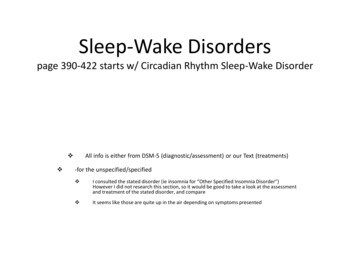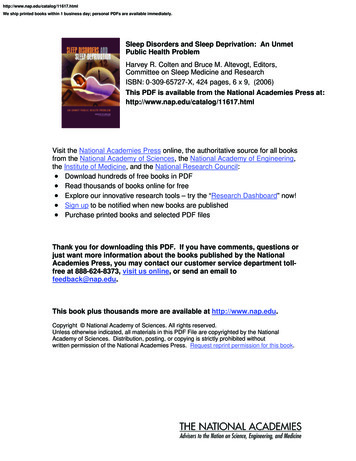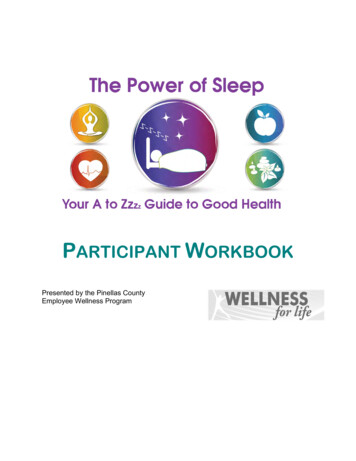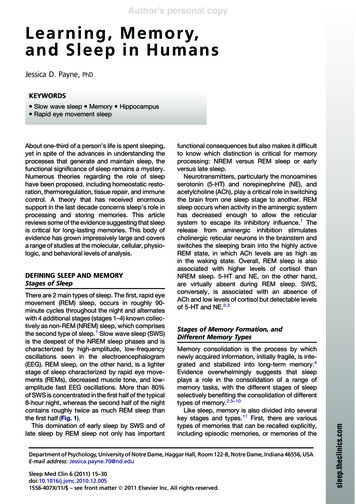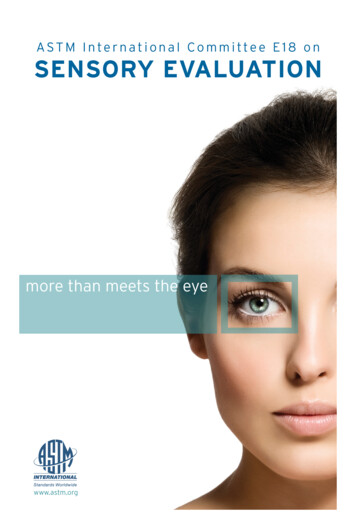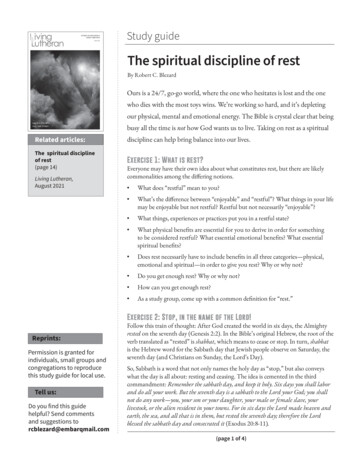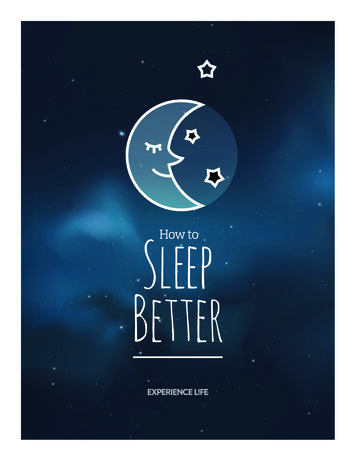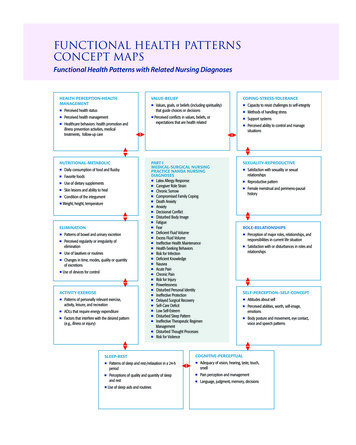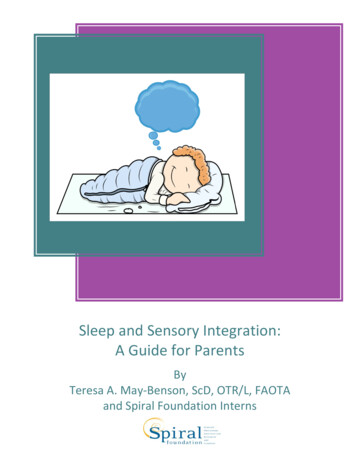
Transcription
Sleep and Sensory Integration:A Guide for ParentsByTeresa A. May-Benson, ScD, OTR/L, FAOTAand Spiral Foundation Interns
About A. Jean Ayres, PhD, OTR, FAOTA, Founder of Sensory Integration TheoryA. Jean Ayres, occupational therapist, developed the sensory integration frame of reference. Dr.Ayres was born in 1920 in Visalia, California. Growing up she struggled with everyday sensationsthat interrupted and impacted her ability to learn like her peers. Dueto her difficult childhood, Ayres was determined to study the reasonswhy children like her had such difficulty with everyday tasks. Sheobtained a master’s degree in occupational therapy and a doctoratein educational psychology from the University of Southern California.Dr. Ayres later completed postdoctoral work at UCLA’s Brain ResearchInstitute where she began to develop her theory of sensoryintegration. Through her work, Dr. Ayres found children with sensoryintegration dysfunction had a neural disorder that affected theirability to interpret and process sensory information, such as touchand movement. From this discovery, she developed assessment toolssuch as the Southern California Sensory Integration Tests (SCSIT) andlater the Sensory Integration and Praxis Tests (SIPT) that helped occupational therapists identifythis disorder in children. She created equipment and treatment techniques, which now serve asthe foundation to sensory integration intervention. This novel intervention approach changedthe way occupational therapists treat children with sensory and motor challenges. Dr. Ayresbelieved therapy should emphasize the power of sensations, be child-directed and be play-basedto make the neural changes necessary to improve the child’s ability to function in everyday life.Throughout the past decades, Ayres’ work has been the foundation for increased understandingof the relationship of sensory processing, motor development and behavior in children. Hertheory and terminology are used by many professions though they remain rooted in occupationaltherapy.Photo A Jean Ayres Jane Koomar. Used with permission.SLEEP AND SENSORY INTEGRATION: A GUIDE FOR PARENTS 2018 Spiral Foundation at OTA-WatertownAll Rights Reserved. No part of this publication may be reproduced or transmitted in any form or by any means, electronic or mechanical,including photocopying, recording or any information storage and retrieval system, without permission in writing from the copyrightowner Spiral Foundation at OTA-Watertown.Clip art and photographs used in this publication are either royalty free artwork obtained from a legally licensed copy of Microsoft OfficeWord 2010 for use by a non-profit organization or purchased from www.istockphoto.com, courtesy of andresrimaging, EpicStockMedia,a-wrangler, 4774344sean, monkeybusinessimages, Johnnyhetfield, and omgimages.Acknowledgements: Portions of this publication originally appeared on the Spiral Foundation website: www.thespiralfoundation.org andwere adapted from material written for the website by Anne Trecker, MS, OTR/L. We would like to acknowledge contributions by: LindaTirella, Amy Danato and Emelia Heckman.Printed in the United States of AmericaPUBLISHED BYSpiral Foundation at OTA-Watertown, 74 Bridge St. Newton, MA 02458 617-969-4410 www.thespiralfoundation.org2 PageSpiral Foundation
Table of ContentsWhat Is Sensory Integration (SI)? 4How Does SI Impact Sleep? . 5Does My Child Have Sleep Challenges? A Checklist . 6Common Sleep Problems in Children . . 7Co-Sleeping . 7Trouble Falling Asleep . 7Sleep Interventions . . 8Creating & Maintaining Bedtime Routines . . 8Getting Ready for Bed: Calming Pre-Bedtime Activities .9Changing the Sleep Environment . . 10Other Considerations . . . .10Sleep Strategies . .11Infants . 12Back to Sleep . .12Tummy Time . 12Sleep Challenges and Autism Spectrum Disorder . . 13References & Resources: Where Can I Learn More? .14Appendix A: Assessment Tools. .153 PageSpiral Foundation
This guidebook was developed to provide an overview of sleep and the impactssensory integration problems and sensory processing disorder have on sleep,strategies to help change sleep patterns/routines, and assessment tools.Maybe your child has becomesocially isolated because theslightest touch feels threatening.What is SensoryIntegration?Maybe your son or daughterstruggles with sleeping and eatingand is irritable much of the day.You, as the parent, think that it isonly a stage, but that doesn’tmake it any easier to deal with.Every day we experienceand interpret sensory information from our environment. This information comesfrom the senses: sight, hearing, touch, taste, and smell, as well as balance andmovement (vestibular sense) and muscle and joint senses (proprioception). Ourbalance and movement sense allows us to know where we are in space and whereour head is in relation to gravity. Our muscle and joint sense allows us to know abouthow much force we use and where our extremities are in relation to our body. All ofthese senses provide us with information about our body and the environmentaround us. The process by which the brain organizes and interprets this informationfrom our senses is called Sensory Integration.For most people, sensory integration develops through typical childhood experiences.Through these experiences, children acquire the ability to interpret, adjust and respondappropriately to incoming sensations. For example, children gain knowledge of theirbody in space through movement activities such as running, swinging and rolling. Thisknowledge allows them to navigate their world safely such as being able to safely timecrossing a busy street. However, for some people, the ability to integrate everydaysensory information does not develop as well as it should. It can result in long-termdifficulties with everyday activities such as work, dressing, eating and self-regulation.When this occurs, the individual has a problem with sensory integration. This problem isfrequently referred to as a Sensory Integration or Sensory Processing Disorder (SPD).Maybe your child is a goodstudent who is determined towork hard but can’t seem to stayorganized or focused at theirdesk.4 PageMaybe your child’s ears fill withpain whenever the fire alarm ringsat school. While everyone else goesoutside, all your child can do is curlup with their hands over their ears.Spiral Foundation
How Does Sensory Integration Impact Sleep?Sleep is an important part of our everyday lives. Our bodies need sleep in order to stayhealthy, think, move, interact, and feel our best. For many people it is difficult to fallasleep, stay asleep, or be comfortable while they are trying to sleep; 30% of childrenhave trouble with sleep (Vasak, Williamson, Garden, & Zwicker, 2015).One reason for these difficulties may be related to the way their bodies experience andreact to the world around them. Stimuli (such as, sights, sounds, touch) may make itdifficult for some children to make their bodies calm and relaxed. Researchers havediscovered that there is a significant link between sleep behaviors/patterns and the waybodies experience sensory stimuli or sensations. In particular, research has found thatchildren who are sensitive to sights, touch, movement, and sound have greater difficultywith sleep (Engel-Yeger & Shochat, 2012; Shochat, Tzischinsky, &Engel-Yeger, 2009).Children with sensory integration (SI) needs are more likely to have challenges fallingasleep, staying asleep, and/or being comfortable while sleeping. Poor sleep not onlynegatively impacts the child, but the whole family. If sleep difficulties go unchecked,they can lead to later-life challenges such as negative behavior, poor self-regulation, anddepression (Vasak, Williamson, Garden, & Zwicker, 2015). Sleep challenges increase if achild has SI challenges that co-occur with a diagnosis of ADHD, ASD, and/or intellectualdisability (Breslin, Edgin, Bootzin, Goodwin2 & Nadel, 2011; Goldman, Richdale,Clemons & Malow, 2012).Parenting styles, cultural values, sibling interaction, family stress, sleep deprivation,occupational balance , napping, sleeping position, medical illness, sleep disorders,psychiatric disorders, and behavioral/developmental difficulties also impact sleep(Vasak, Williamson, Garden, & Zwicker, 2015).5 PageSpiral Foundation
Does My Child Have Sleep Challenges? A ChecklistThe BEARS acronym is a very helpful way to check in aboutyour child’s sleep:Bedtime:Does your child have difficulty falling asleep or going to bed byhimself/herself?Excessive daytime sleepiness: Does your child have difficulty waking up or seem groggyor sleepy throughout the day?Awakenings at night: Does your child wake up at night? Can he/she fall back to sleep byhis/herself?Regularity: What is your child’s typical bedtime and wake-up routine?Snoring: Does child snore or stop breathing, gasp, or choke during sleep?(Owens & Mindell, 2005)A “yes” to Bedtime, Excessive daytime sleepiness, Awakenings at night, and/orSnoring questions can indicate a sleeping challenge. If your answer for Regularityindicates that your child does not have a consistent bedtime and/or wake-up routine,that can also indicate a sleeping challenge. Some of these sleeping challenges may berelated to sensory processing difficulties.Keep in mind that snoring can be due to many differentreasons (impacted tonsils or adenoids; a condition such assleep apnea or asthma). If your child snores, you should bringhim to a clinician as soon as possible to determine the bestphysiological supports for sleep.6 PageSpiral Foundation
Common Sleep Problems in ChildrenWhile there are many different reasons a child has trouble sleepingthe two main problems parents encounter with their children’ssleeping habits are that their child cannot fall asleep and/or that inorder to get their child to sleep they must co-sleep with a parent.Trouble Falling AsleepChildren can have trouble falling asleep for many different reasons including but notlimited to, the environment that the child is in, the sleep clothes the child is wearing, theactivities done that lead up to bedtime, and the child’s habits around falling asleep.Try to follow different sleep interventions listed on pages 8-11 to see which ones workbest for your child and your family.It is important to give your child the opportunityto learn how to fall asleep independentlystarting at a young age. Constantly holding orrocking a baby until they fall asleep or sleepingCo-SleepingMany parents find that the only way they can get their child to sleep is by either havingthe child sleep in their bed or room, having a parent sleep in the child’s bed or room, orallowing their child to come into their bedroom in the middle of the night when theywake up. If co-sleeping is absolutely necessary: Get a wall barrier for the bed if you have an infant or small child so you donot roll on your baby and possibly smother them. Have your child sleep in a sleeping bag or on a portable mattress on thefloor of your room instead of directly in the bed with you. If the child prefers you sleep in their bed, transition to sleeping on the floorinstead. Having a bed in an infant’s room instead of the infant’s bed in your roomwill make it easier for the parent to move rather than the baby- giving theinfant a more restful sleep.The end goal is to eventually transition your child so that they are able to fall asleep in areasonable amount of time and stay asleep in their own bed independently. Reviewsome of the sleep strategies on page 11 for ideas on how to make this transition foryour child.7 PageSpiral Foundation
Sleep InterventionsTo change sleep patterns new routines and habits must be formed around bedtime aswell as during the time leading up to bed. The environment in which the child sleeps isanother important factor to consider. For children with SPD or SI needs, environmentalfactors around them (i.e sheets or pajamas) can significantly influence their sleep (MillerKuhaneck & Watling, 2010).Creating and Maintaining Bedtime RoutinesOne of the best ways to help support your child’s sleep is to create and maintain abedtime routine (Goldman, Richdale, Clemons & Malow, 2012). Completing a routinebefore bed is a great way to help the mind and body prepare for sleep. Carrying out abedtime routine signals the body that it is about to go to bed. It may take some time tofigure out what kind of routine works best for you, your family, and most importantlyyour child. Experimentation, creativity, and flexibility are important in this process.Once you figure out a plan that works for you and your child, stick to it! Consistency iskey! The bedtime routine, and time for the routine, should be consistent and shouldwork for all members of the family. The routine can be simple and short. Someexamples of types of things to include in a routine include, but aren’t limited to: drink a glass of water, brush teeth, and put on pajamas; do 15 pushups, wash face, and set alarm clock; use the bathroom, choose an outfit for the morning, and crossthe day off on the calendar.The best routine for your family is onethat includes completingthe same set of activities around thesame time each night.Sleep issues can be very stressful forfamilies. It’s a good idea to be open to asmany suggestions and possibilities aspossible.8 PageSpiral Foundation
Getting Ready for Bed: Calming Pre-Bedtime ActivitiesIt is difficult for most people’s bodies to suddenly switch from“daytime mode” to “sleep mode.” If you find your child puts offgoing to sleep or lays in bed waiting for his body to feel ready forsleep, some of the following activities may be beneficial. Children with SPD oftendemonstrate sensory seeking behaviors around bedtime that cause over arousal (MillerKuhaneck & Watling, 2010). It is important to lower the child’s arousal state and to calmhim or her down to allow the child to fall asleep and stay asleep. Steps can be takenthroughout the day that will help to decrease a child’s arousal before bedtime.The following activities focus on decreasing bothersome or alerting stimuli (sights,sounds, etc.) and increasing calming stimuli/sensations: Avoid bright screens (TV, computer, phone, iPad) Relax in a dim, quiet space before heading to bed Choose a relaxing activity, like reading, drawing, jigsawpuzzle, word/number games (Sudoku, crossword, wordsearch), cards, or knitting Listen to quiet music that is soothing Wrap body tightly in a blanket or sit under a weighted blanket Take a warm shower or bath Meditate or do light yoga Getting a tight hug from a family member, or roll an exercise ballfirmly over your child’s back while they lie on a mat Rhythmic motion, such as gently rock in a rocking chair, can be soothing. Deep breathing or sucking may help the body feel more calm and ready forsleep; for example, blow up a balloon several times, drink roomtemperature water through a straw, or suck on a sugarless mint.Heavy work activities may be helpful if your child feels the need to movebefore going to bed. For example, doing laundry, wall pushups,manipulating clay/putty, or tossing and catching a weighted ball can becalming.Allow for plenty of movementopportunities throughout the day forthe child. For example, running,jumping, and swinging.9 PageSpiral Foundation
Changing the Sleep EnvironmentThe environment plays an important role in how the body feels, responds, andcompletes activities throughout the day. Bedtime and sleep are no exception. Especiallyfor children with SI the environment before bedtime needs to be as optimal as possiblefor the child. The following list provides some suggestions for creating an environmentfor sleep that may help your child fall asleep faster, stay asleep longer, and experiencesleep more comfortably: Paint your child’s room a color that he/she finds soothing. Hang room darkening shades/curtains if light bothers your child. Make the bed with sheets and a quilt/comforter that are a soothing, solidcolor or have a simple pattern. Close the door to the bedroom to reduce light and sound. Play/listen to a soft, soothing noise (if noises are not bothersome ordistracting), such as: music, sound machine, fan, air purifier. Sleep under a heavy quilt, comforter, or blanket – the deep pressure can besoothing. Tuck the sheets under your child’s mattress on one or both sides; this canprovide soothing deep pressure. Sleep with a body pillow, pet, or stuffed animal in the bed – it can providedeep pressure or a sense of boundaries in a large bed. Use 100% cotton or flannel sheets and launder them with short wash cyclesto avoid pilling. Wash new sheets and pajamas several times to make the fabric feel softer. Put sheets and/or pajamas in the dryer five minutes before bedtime- thewarmth can be soothing for some children. Keep the room cool. A decrease in body temperature signals the transitionto sleep.Other Considerations Parents and families may have different thoughts about co-sleeping. Considerations for co-sleeping include keeping a distinct space in theparents’ room for the child to use to help transition out of the parents’ bed(e.g. crib, sleeping bag). Adopted children may need additional emotional supports for sleeping. If your child uses a CPAP machine, build the CPAP machine into yourbedtime routine. Children who have experienced trauma may have individualized needs tofeel safe while sleeping (e.g. need a door open or a night light on).10 P a g eSpiral Foundation
Sleep StrategiesSleep challengeChild and parent share a bed to get childasleep and to stay asleep.Strategy Put a shirt or other article of clothing that wasworn all day by a parent on the child’s pillowor anything else they sleep with at night (i.e.stuffed animal) as the parent’s scent maybecomfortingChild is afraid to sleep alone in his/herbedroom. Pick a special stuffed animal and give it“special powers” that will scare off anymonsters and protect the child as they sleepChild wakes up in the middle of the night. Provide child with a deep touch pressuremassage. Reduce pressure as the child beginsto fall asleep.Child is sensitive to the fabrics of theirsheets or pajamas making it hard for themto fall asleep. Use 100% cotton bedding (especially sheets)wash the sheets a few times before puttingthem on the bed to soften the fabric (flannelmay be particularly useful)Make sure the child’s pajamas are soft as wellby washing them a few times before wearingand make sure to cut all tags off Child is restless and overactive due to higharousal level. 11 P a g eConsider getting the child a weighted blanketto sleep with- this will provide constant deeptouch pressure to calm the child.Get the child spandex pajamas or sheets- bothor either will also provide deep touch pressurePut a body pillow or two in the bed to allowthe child to be able to “squish” themselvesbetween themPosition the bed against a wall so the child cansquish themselves against itHave the child sleep in a sleeping bag tocreate a squishing sensation- add a bodypillow in for extra deep touch pressureSpiral Foundation
InfantsAlthough many parents are afraid to place their infant on their stomach it is importantfor babies to spend time in varied positions including both on their stomachs and theirbacks.Back to SleepThe Back to Sleep campaign encourages parents to place their child on their back whenthey sleep to help prevent sudden Infant Death Syndrome (SIDS). While this initiativehas saved lives, it has contributed to sleeping problems, fine and gross motorcoordination delays, postural control difficulties, and reflux. The supine (on back) sleepposition is most important for infants up to four months of age and those vulnerable toprematurity, illness, or other factors. Babies may have trouble adjusting to sleeping ontheir backs after being in the womb for nine months. The following list of suggestionscan help your infant adjust to sleeping in this position: Use a crib wedge against the baby’s back. Swaddle the baby at night (recommended up until fivemonths or until the baby begins to roll around).Be sure to change your child’s head positioneach night so they do not acquire a flat head.Tummy TimeFor infants, being able to spend as much time as possible on their stomach throughoutthe day is crucial to their development. Placing your infant on their stomach while theyare awake and under supervision and having them stay in that position allows for thedevelopment of shoulder stability along with their neck and back muscles. Being in theprone position also starts to encourage the child to move around.To encourage your child who is protesting tummytime, place them on your stomach so you and thechild are face to face.Use as much time as possible engagingand playing with the child while theyare on their stomach.12 P a g eSpiral Foundation
Sleep Challenges and Autism Spectrum DisorderWhile sleep challenges are common in approximately a quarter of typically developingchildren, between 40% and 80% of children diagnosed with autism spectrum disorder(ASD) have reported sleep challenges (Cortesi, Giannotti, Ivanenko & Johnson, 2010;Goodlin-Jones, Tang, Liu, & Anders, 2009; Krakowiak, Goodlin-Jones, Hertz-Picciotto,Croen, & Hansen, 2008). These children often: Have trouble falling asleep Do not sleep the appropriate amount of time for their age Wake up frequently after falling asleep Are awake in bed more than they are asleep Take a long time to calm/settle down before bed Get out of bed to play Snore, stop breathing, gasp or choke during sleepIf your child does/has any of these sleep challenges then it is most likley affecting theirfunctioning during the day and could contribute to (Mazurek & Sohl, 2016): Trouble focusing Trouble controlling impulses Increased irritability Increased aggression Increased repetitive behaviors Difficulty communicatingIt is important to establish a routine with your child before bedtime that consists ofcalm, relaxing, and quiet activities. Routines should vary slightly to keep your childfrom becoming stuck on a specific routine (Miller Kuhaneck & Watling, 2010).Children with Autism Spectrum Disorder react wellto positive routines. Creating these routines alongwith other positive reinforcement will help yourchild get more sleep (Miller Kuhaneck & Watling,2010).13 P a g eSpiral Foundation
Resources & References: Where Can I Learn More?Websites on Sensory Processing Disorder & Sensory Integration: The Spiral Foundation: www.thespiralfoundation.org Sensory Processing Disorder Foundation: www.spdnetwork.org SI Global Network: www.siglobalnetwork.org Sensory Processing Resource Center: www.sensory-processing-disorder.comBreslin, J.H, Edgin, J.O., Bootzin, R.R., Goodwin, J.L. and Nadel, L. (2011). Parental reportof sleep problems in down syndrome. Journal of Intellectual Disability Research,55(11), pp. 1086-1091 doi: 10.1111/j.1365-2788.2011.01435.xGoldman, S.E., Amanda L. Richdale, A.L, Clemons, T. & Malow, B (2012). Parental sleepconcerns in autism spectrum disorders:Variations from childhood to adolescence.Journal of Autism and Developmental Disorders, (42), p. :531–538. DOI10.1007/s10803-011-1270-5Engel-Yeger, B., & Shochat, T. (2012). The relationship between sensory processingpatterns and sleep quality in healthy adults. Canadian Journal of OccupationalTherapy, 79(3),134-141. doi: 10.2182/cjot.2012.79.3.2Miller Kuhaneck, H., & Watling, R. (2010). Autism: A comprehensive occupationaltherapy approach. 3rd edition. Bethesda, MD. American Occupational TherapyAssociation, Inc.Owens, J. A., and J. A. Mindell. "Take charge of your child’s sleep." New York, NY:Marlow & Company (2005).Shochat, T., Tzischinsky, O., & Engel-Yeger, B. (2009). Sensory hypersensitivity as acontributing factor in the relation between sleep and behavioral disorders innormal school children. Behavioral Sleep Medicine, 7(1), 53-62,doi:10.1080/15402000802577777Vasak, M., Williamson, J., Garden, J., & Zwicker, J. G. (2015). Sensory processing andsleep in typically developing infants and toddlers. American Journal ofOccupational Therapy, 69, 6904220040. doi.org/10.5014/ajot.2015.01589114 P a g eSpiral Foundation
Appendix ASensory Integration & Sleep Assessment ToolsBelow are some assessment tools your occupational therapist may use to help identifyfactors that may contribute to your child’s sleep problem.Infant/Toddler and Child Sensory ProfileA parent/caregiver questionnaire used to help determine a child’s sensory processingcharacteristics. The Parent/caregiver uses a 5-point scale to rate the frequency of abehavior (e.g., “My child gets fussy when exposed to bright lights”) on a 5-point scale.The ITSP asks questions that cover all senses. The results of the questionnaire indicatehow a child recognizes (registers) and responds to stimuli. For instance, a child can havelow or high registration, and seek or avoid stimuli.Brief Infant Sleep QuestionnaireThe BISQ asks parents/caregivers 15 questions about the sleep behavior of theirchild(ren), including questions about the amount of time the child sleeps during thenight, the amount of sleep the child gets during the day, the average time the child isawake during the night, and the time it takes the child to fall asleep once she is put tobed.Children’s Sleep Habits QuestionnaireThe CSHQ is similar to the BISQ, but for an older age group. It is also a parent/caregiverquestionnaire, asking 45 questions about a child’s sleep habits, rated on a 3-point scale(1 rarely, 2 sometimes, 3 usually). It measures sleep anxiety, sleep duration, sleeponset delay, night wakings, bedtime, disordered breathing, parasomnias, and daytimesleepiness. It also asks the parent/caregiver to label the behavior as a problematic ornot problematic.**Note: There are many standardized assessments available. These are commonly used tests but thislist is not inclusive of all possible assessment tools. Your clinician will select assessments individuallyfocused on your needs.15 P a g eSpiral Foundation
Sleep is an important part of our everyday lives. Our bodies need sleep in order to stay healthy, think, move, interact,and feel our best. For many people it is difficult to fall asleep, stay asleep, or be comfortable while they are trying to sleep; ildren 30% of ch have trouble with sleep
